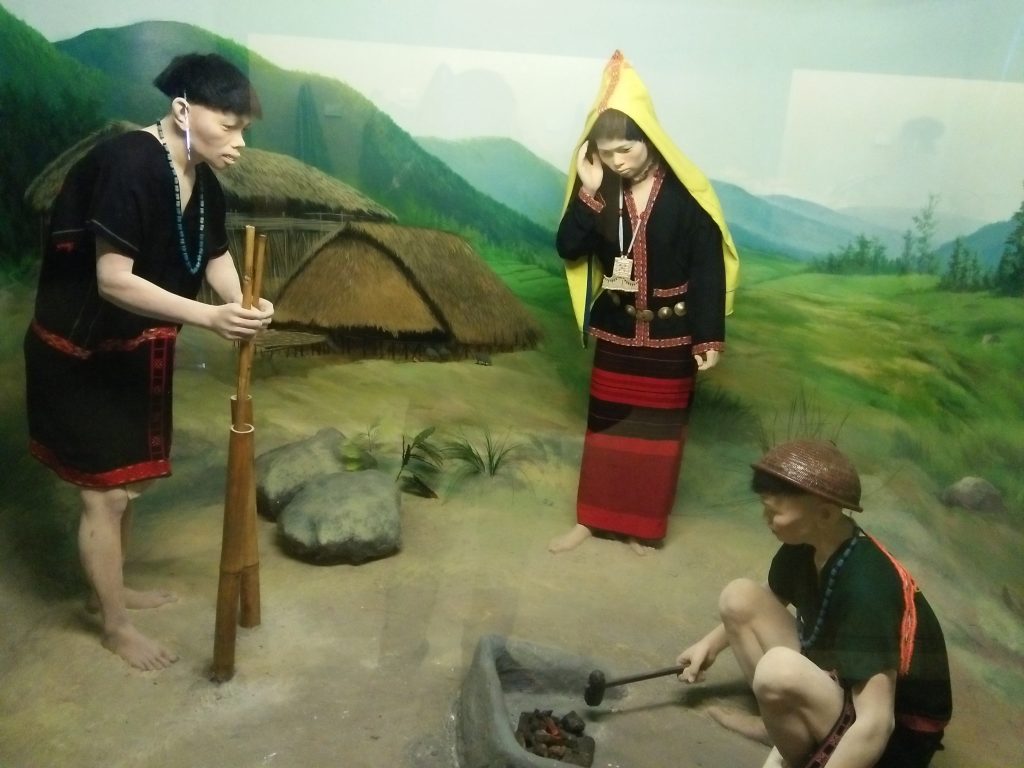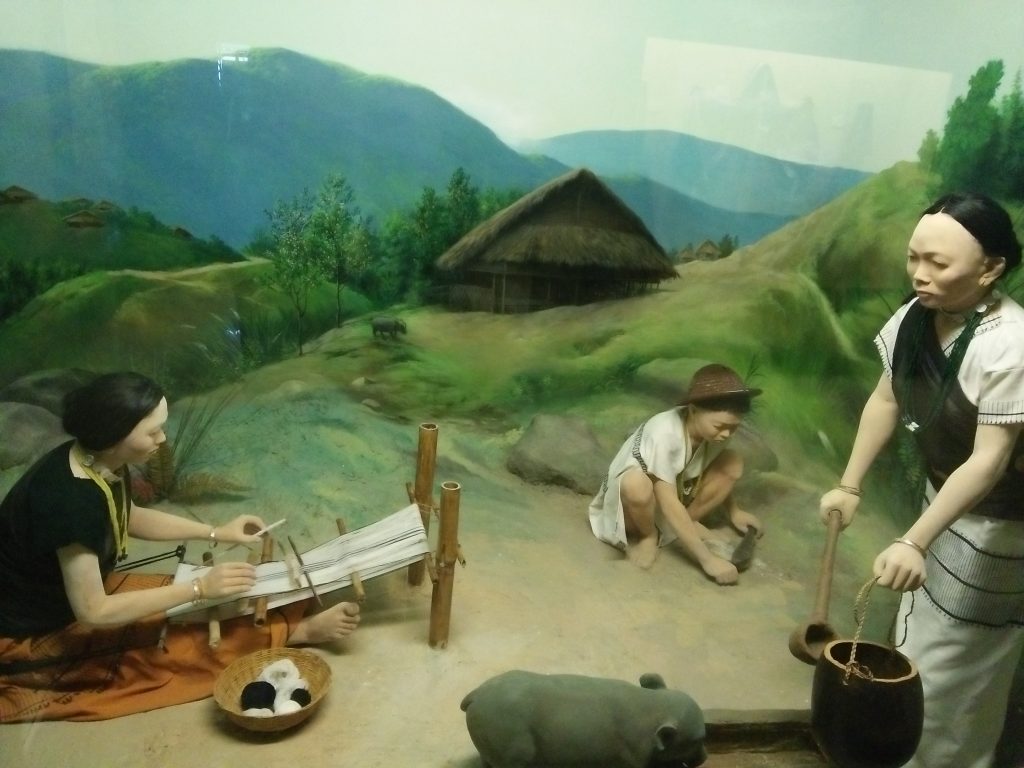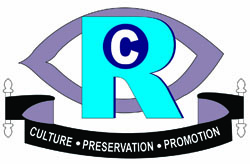History: It is indeed to say that the Museum movement in Arunachal Pradesh actually got momentum after joining of late Dr. Verrier Elwin, the then Adviser for Tribal Affairs in the year 1954 and given the responsibilities of Research Department as its Head. However in the formative stage the idea for setting up Central Museum at Shillong was mooted by Late L.N. Chackraborty, the then Historical Research Officer after his joining in Research department. Keeping in mind it’s important and considering Nehru’s Vision, he put forward a scheme to N.K. Rustomji, the then Advisor to Governor. The scheme was approved and directed to the Research Officer to issue a circular to all the Political Officer to collect the artefacts for starting a museum in the year 1953 .
The overall guidance and supervision of the late Dr. Verrier Elwin establishment of museums in Arunachal Pradesh for preservation and promotion of material culture of the people was prompted by the guiding principles and philosophy of late Pandit Jawaharlal Nehru the then Prime Minister of India. Elwin could probably visualize the after effect of the winds of change, which was just starting blowing in the hitherto unknown land of rising sun. Modern gadgets of the civilized world started penetrating slowly in the different parts of the area and the people were facing the process of transition in the implementation of the various developmental programmes. In other tribal areas of the world urbanization and modernization had already caused sufficient damages to the traditional culture of the people by then. This was another factor, which made Dr. Elwin initiate setting up of the museums in Arunachal Pradesh, the then NEFA. The Central Museum was organized at Shillong in the year 1956 and subsequently six district museums one each at Bomdila, Ziro, Along (presently Aalo), Pasighat, Tezu and Khonsa were set up within 1965.
The People And Their Material Culture:
The people of Arunachal Pradesh have a rich socio-cultural heritage. Each society has its own code of ethics followed from time immemorial and continued till today. Traditions are respected. In respect of handicrafts, Arunachal Pradesh may be called a veritable reservoir, here we find weaving, painting, basketry, mask- making, ivory- work, black smithy, doll making, pottery, carpentry, paper- making, smithy work and so on. The women of Arunachal are expert in the art of weaving. They are very particular about colours and have a beautiful sense of colour combination. Carpet making is the speciality of the Monpa girls. Wood carving is a tradition with some of the tribes of Arunachal Pradesh like Monpas, Khamtis and Wanchos. Cane and Bamboo handicrafts are of a very high standard. Cane and Bamboo products fulfill their all day to day necessities as they produces Hats of different sizes and shapes, various kinds of baskets, cane vesels, cane belts, elaborately woven brassieres of cane and fibre, a variety of ornaments and necklaces. Ornament making is another craft very widely practiced in the state.
The Ethnographic Museums of Arunachal Pradesh and Their Display:
The Museums of Arunachal Pradesh established since 1956 are ethnographic. In the ethnographic museums there are altogether a little over seven thousand specimens which includes textiles, basketry, pottery, woodcarving, dress and ornaments, headgears, weapons of war and chase, agricultural tools and implements, fishing implements, scroll paintings, household articles, masks, heirlooms and musical instruments. Of late, display maps of fine arts work on different subjects such as people of Arunachal, house-types, festivals, dances, historical and archaeological sites, handicrafts etc. have been added through the visual media. Most of the district museums have been enriched with portable miniature diorama and the J. N. State Museum with life size diorama on various aspects of life and culture of the people, various socio-economic activities on its enchanting ecological and social milieu. The state museum is located at Itanagar, the State capital of Arunachal Pradesh and all the district museums are located in the central place of the district headquarters to facilitate easy access to the visitors. Efforts are being made to establish museum in each of the headquarters of the newly established districts.
One more ethnographic museum, named Arunachal Pavilion set up by the Directorate of Research, Govt. of Arunachal Pradesh, Itanagar in the year 2009(January) within the campus of Shilpgram, located at Panjabari, Guwahati in the State of Assam, in which the material culture of various Arunachalee ethnic tribes and important historical and archaeological sites has been depicted in the line of other north- eastern states. This has been done in collaboration with the Directorate of Art & Culture, Govt. of Arunachal Pradesh, Itanagar under direct supervision of NEZCC(North East Zone Cultural Centre) with its headquarter at Dimapur, Nagaland.
Presently the Arunachal Pradesh has 12 (twelve) ethnographic museums, out of which 11(eleven) in function and 1(one) yet to be functional, such as:-
| Sl.No. | Name of the Museum | Location | District |
| 1 | Jawaharlal Nehru State Museum | Itanagar(State capital) | Papum Pare |
| 2 | District Museum | Tawang | Tawang |
| 3 | District Museum | Bomdila | West Kameng |
| 4 | District Museum | Seppa | East Kameng |
| 5 | District Museum | Ziro | Lower Subansiri |
| 6 | District Museum | Daporijo | Upper Subansiri |
| 7 | District Museum | Aalo | West Siang |
| 8 | District Museum | Pasighat | East Siang |
| 9 | District Museum | Tezu | Lohit |
| 10 | District Museum | Changlang | Changlang |
| 11 | District Museum | Khonsa | Tirap |
| 12 | District Museum | Roing (yet to be functional) |
Lower Dibang Valley |
![]()
The Jawaharlal Nehru State Museum:
The J. N. State Museum is headed by Deputy Director of Research (Museum & Archives) being a sectional head assisted by Assistant Curator/Keeper under administrative control of Director of Research while the District Museums are managed by the Assistant Curators and Keepers under administrative control of District Research Officers.
Jawaharlal Nehru State Museum formerly called Central Museum was established at Shillong (Meghalaya), the then NEFA headquarter, and initially housed in two rooms attached with the Advisor ’s office at Secretariat building.
Then in the year 1990 entire collection of the museum was shifted to Itanagar, the State capital and it has been re-organized
in a new building and rechristened it as the Jawaharlal Nehru State Museum to commemorate the birth centenary of Pandit Jawaharlal Nehru. The foundation stone of the new building was laid on 3rd
Gallery of The J.N State Museum: Itanagar
February, 1988 by the then President of India R. Venkataraman and the Museum was inaugurated by R. D. Pradhan, the then Governor of Arunachal Pradesh on 1st January 1990.The J. N. State Museum is a beautiful and well designed having two storied building and located at a prime location in Itanagar. The State Museum has two exhibition floors and an auditorium for various activities. The ground floor is used for depicting and portraying various aspects of tribal way of life with the help of dioramas, maps etc. and a provision for orientation area. The ground floor gallery had renovated and developed by the Indian Museum, Kolkata in the year 2006. Now the gallery has completely been transformed into a state-of-the-art gallery in tune with world class museum incorporating all aspects of modern scientific concept of the museum practices. The upper floor (first floor) has eight galleries with the collections belonging to different ethnic communities of Arunachal Pradesh. The eight galleries are categorized as textile, archaeology, basketry, painting, war and chase, wood carving, house-hold articles, ornaments. The upper floor 5 galleries have also been renovated / developed with the support and help from the Victoria Memorial Hall, Kolkata. There are all together 2421 specimens in the collection out of which more than 800 specimens are on display in the state museum.
On another venture of development a “Mountaineering Gallery” was set up in the Jawaharlal Nehru State Museum, Itanagar with introduction of new subject for the first time in the museum and first of its kind in the region. This is aim to encourage the new generation particularly students to inculcate their interest to take up this adventure event as their carrier. The proposal was first mooted in the year 2009 when Mr. Tapi Mra, first Arunachalee Mountaineer was conquered Mount Everest at the height of 8848 mtr and created a niche in the history of the State in the field of mountaineering. He donated his entire mountaineering kits to the museum for the noble gestur






List of Officers/ Officials (Museum Personnel):
- Shri N. Ray, Keeper, J.N. State Museum, Itanagar.
- Shri Anil Dutta, Laboratory Assistant, J.N. State Museum, Itanagar.
- Smti Yalu Mudang, Receptionist, J.N. State Museum, Itanagar.
- Shri Chera Tania, Arm Guard, J.N. State Museum, Itanagar.
- Smti Chera Meema, Museum Cleaner, J.N. State Museum, Itanagar.
- Smti Mize, Museum Cleaner, J.N. State Museum, Itanagar.
- Smti Kime Yare, Chowkider, J.N. State Museum, Itanagar.
- Shri Lal Sai Gour, Contingency Staff.
- K.S. Dey, Assistant Curator, District Museum, Bomdila, West Kameng District.
- Shri S. Dutta, Keeper, District Museum, Bomdila, West Kameng District.
- Shri D.K. Bhowal, Keeper, District Museum, Seppa, East Kameng District.
- Shri Tage Tabin, Assistant Curator, District Museum, Ziro, Lower Subansiri District.
- Shri Tage Gambo, Projector Operator, District Museum, Ziro, Lower Subansiri District.
- B. Paul, Assistant Curator, District Museum, Daporijo, Upper Subansiri District.
- Shri Omak Darin, Keeper, District Museum, Aalo, West Siang, West Siang District.
- Shri R.B. Chetry, Keeper, District Museum, Pasighat, East Siang District.
- Shri B. Sonar, Assistant Curator, District Museum, Tezu, Lohit District.
- Shri H.C. Baruah, Assistant Curator, District Museum, Changlang, Changlang District.
- Shri N.J. Hazarika, Keeper at Arunachal Pavilion, Shilpgram, Guwahati (Assam).





